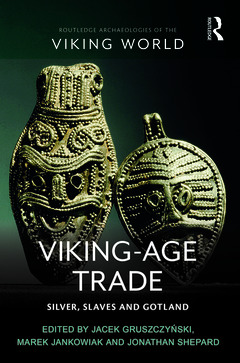Viking-Age Trade Silver, Slaves and Gotland Routledge Archaeologies of the Viking World Series
Coordonnateurs : Gruszczyński Jacek, Jankowiak Marek, Shepard Jonathan

That there was an influx of silver dirhams from the Muslim world into eastern and northern Europe in the ninth and tenth centuries is well known, as is the fact that the largest concentration of hoards is on the Baltic island of Gotland. Recent discoveries have shown that dirhams were reaching the British Isles, too. What brought the dirhams to northern Europe in such large numbers? The fur trade has been proposed as one driver for transactions, but the slave trade offers another ? complementary ? explanation.
This volume does not offer a comprehensive delineation of the hoard finds, or a full answer to the question of what brought the silver north. But it highlights the trade in slaves as driving exchanges on a trans-continental scale. By their very nature, the nexuses were complex, mutable and unclear even to contemporaries, and they have eluded modern scholarship. Contributions to this volume shed light on processes and key places: the mints of Central Asia; the chronology of the inflows of dirhams to Rus and northern Europe; the reasons why silver was deposited in the ground and why so much ended up on Gotland; the functioning of networks ? perhaps comparable to the twenty-first-century drug trade; slave-trading in the British Isles; and the stimulus and additional networks that the Vikings brought into play.
This combination of general surveys, presentations of fresh evidence and regional case studies sets Gotland and the early medieval slave trade in a firmer framework than has been available before.
1. Why Gotland?
Part I: Cogs and Drivers
2. Reading between the lines: Tracking slaves and slavery in the early middle ages
3.Slavery in medieval Scandinavia: Some points of departure
4. The fur trade in the early middle ages
5. The dynamics of the drugs trade: A model for the study of the medieval trade in slaves?
Part II: Flows from Islam
6. Dirham flows into northern and eastern Europe and the rhythms of the slave trade with the Islamic world
7. Trading networks, warlords and hoarders: Islamic coin flows into Poland in the Viking Age
8. Coin circulation in early Rus and the dynamics of the druzhinas
Part III: Gotland
9. Hoards, silver, context and the Gotlandic alternative
10. Hoards and their archaeological context: Three case studies from Gotland
11. Gotland: Silver island
12. Silver hoards and society on Viking-Age Gotland: Some thoughts on the relationship between silver, long-distance trade and local communities
13. From the foreign to the familiar: The arrival and circulation of silver in Gotlandic society
14. Was there life before death? The Viking settlements on Gotland
15. Social structures and landscape: Gotland’s silver hoards in the context of settlements
Part IV: Comparisons
16. Gotland viewed from the Swedish mainland
17. Silver hoarding on Bornholm and Gotland: Hoards as windows onto Viking-Age life
18. Coins as an indicator of communications between the British Isles and Scandinavia in the Viking Age
19. Viking economies and the Great Army: Interpreting the precious metal finds from Torksey, Lincolnshire
20. Viking-Age bullion from southern Scandinavia and the Baltic region in Ireland
Part V: Conclusions
21. Some reflections on Gotland: Slavery, slave-traders, and slave-takers
Jacek Gruszczyński was a Research Associate at the Khalili Research Centre, University of Oxford and now works as an archaeology and heritage consultant.
Marek Jankowiak is Associate Professor of Byzantine History at the University of Oxford.
Jonathan Shepard was University Lecturer in Russian History at the University of Cambridge.
Date de parution : 04-2022
15.6x23.4 cm
Date de parution : 10-2020
15.6x23.4 cm
Thème de Viking-Age Trade :
Mots-clés :
Otto III; medieval history viking studies archaeology numismatics slavery; Guta Saga; Trans-continental scale; Viking Age; Viking-age trade; Young Men; British Isles; Vita Anskarii; Viking Age Silver Hoard; Staraia Ladoga; Silver Hoards; Viking Age Settlements; Late Viking Age; Viking Age Hoards; Islamic Coins; Viking Age Scandinavia; Above Ground; Viking Age Trade; Early Viking Age; Sorte Muld; Find Spots; Mainland Scandinavia; Metal Detector Surveys; Cuerdale Hoard; Volga Bulgaria; Volga Bulgars; Vendel Period; Rus Lands



